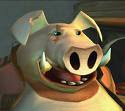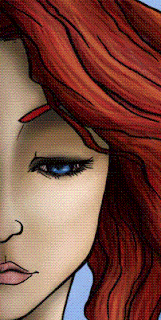 With Christmas well and truly behind me and the flood of blockbuster next-gen titles temporarily receding, I've taken the time to catch up on some overlooked gems from my PlayStation 2 collection, in particular Beyond Good & Evil.
With Christmas well and truly behind me and the flood of blockbuster next-gen titles temporarily receding, I've taken the time to catch up on some overlooked gems from my PlayStation 2 collection, in particular Beyond Good & Evil.This is a game from Michel Ancel, the creator of Rayman. At the time of its release, it sold poorly, but it's picked up steam as a cult classic and the general consensus on the blogosphere is that it's time to revisit Beyond Good & Evil with kinder eyes.
I'm glad I did. The game is excellent. After playing through the recent Prince of Persia I had been thinking to myself, "I want more like this," and now I'm feeling a little stupid because it turns out I had "more like this" sitting on my shelf for the better part of two years, completely unplayed.
In Beyond Good & Evil you play as Jade, photographer and surrogate big sister to a gaggle of assorted orphans. When Jade's adopted planet of Hillys is attacked by the militaristic DomZ armies, Jade is pressed into service to find out what the DomZ are up to and why, exactly, the local defence forces aren't doing much about it.
I say that it's a bit like Prince of Persia, and by that I really mean that it handles relationships between the core characters well. Jade is aided by her "Uncle Pey'j", an avuncular pig-man with a gift for mechanics. (Actually, Hillys is populated by all manner of animal-people, although it spurns catgirls and bunny-women in favour of antropomorphic sharks, rhinos and goats.) Later on you'll also team up with "Double H", a likeable resistance fighter who's forever quoting his role models "Johnson & Peters". These characters are really enjoyable to be around, and when the game makes you go solo you'll really feel their loss. The interactions with Pey'j and Double H form the emotional spine of the game.
Really, though, the gameplay is more like Metal Gear Solid meets Pokemon Snap. Jade's role as a photographer isn't a mini-game or sidequest - it's the core of the game. All your efforts are ultimately directed and getting access to places where you can take photos which reveal the truth of the DomZ plan. You compose and shoot your photos yourself, and the game stores the photos you've taken and weaves them into the game in unexpected places, notably to excellent effect in the game's final scenes.
To keep you busy between plot photographs, you're also challenged to photograph every animal species on Hillys, of which there are I think 50-something. Some of these are ubiquitous but others will require finding some very specific environments. The animals are beautifully unique and make sense in the context of the biosphere; finding the rarer specimens can be really breathtaking, whether it's turning out the lights in a deep cave to capture an unrecorded bioluminscent algae in full glow, or catching a giant blue whale in mid-leap as it breaches the waves. The nature photography is so excellent that I found myself wishing that it could have been the main plot.
Sadly, the other half of the game is stealth. Despite my love of Metal Gear Solid I've never enjoyed having to be stealthy, and I like it best as a vehicle for getting myself in the prime position for completely eliminating every guard in sight. Beyond Good & Evil does a pretty passable job at this type of gaming - the controls are tight and responsive, for example - but it still doesn't quite get it right.
The camera doesn't give you anywhere near enough information. It's not clear how many guards are around, where they're walking, or where they can see. This turns the stealth sections into frustrating trial-and-error processes where you'll proceed halfway across an area, realise there's an extra guard you couldn't see, get caught, and have to restart. Thankfully checkpoints are extremely generous and well-placed. Also, the consequences of detection vary. Sometimes you'll merely end up fighting the guards, which is an appropriate punishment as you'll usually win but at a severe cost to your health. On other occasions, however, detection results in immediate death from a previously-invisible hovering laser orb that can apparently shoot through walls.
Were it not for the stealth sections, this would be an extremely casual-friendly game. Nothing anywhere else in the design comes close to replicating the frustration and repetition of the sneaking missions; every time I started into a guarded area I came close to giving up the game for good and I ended up playing with a walkthrough in hand to minimise my negative experiences.
Everything other than the stealth is perfect, though. You can cruise around the watery surface of Hillys in a hovercraft, compete in suprisingly entertaining hovercraft races, discover hidden nooks and crannies, collect valuable pearls, and explore the pedestrian district of Hillys' main city.
That city, by the way, is a triumph. The main canals that connect everything are packed with an amazing variety of water-borne and airborne vehicles moving in every direction at once, while giant television screens hovering in the air boom out propaganda messages. This kind of business is something we've seen in videogames elsewhere, but the fact it intrudes out into the player's space - the other vehicles are using the same areas that you can use - makes it feel real and immediate and alive. It has an effect something like the cantina from Star Wars, giving you the impression of this being a real, diverse world, through the use of only a single scene. The city also grows and changes as you play, with the propaganda messages changing to reflect your exploits and growing numbers of citizens protesting in the streets as you take more photographs and uncover more of the truth.
The graphics are gorgeous. Despite being rendered on a last-generation system I had no cause to fault anything visual about the game. This is largely because it relies less on technical prowess than it does on genuine art; good aesthetics is good aesthetics at any level of resolution. These are clearly deliberate choices - for example, the art uses simple lines and blocky, childlike shapes for all the Hillyan characters, while making the Domz significantly more visually complex, with assymetries and irregular silhouettes. (The only Hillyan to copy this design style is Pey'j, presumably to reinforce him as a "grown-up" and set him apart from the "child-like" Hillys. It's worth noting also that, story-wise, he's not a Hillyan native.)
Jade is a textbook example of how to do a modern female protagonist. She's dynamic, interesting, competent and attractive, without being sexualised, gimmicky or shallow. Part of what makes her work is that she's "just a person", and a late-game twist that sheds new light on her background feels weak precisely because it violates her identity as someone "normal".
The music is fantastic. I've had it stuck in my head for days after I've finished playing the game, and the main theme is a genuine gaming classic.
I love the story, I love the art, I love the characters, I love the thrilling unexpected action set-pieces (in particular an amazing rooftop chase), I love that the action facilitates the story rather than vice versa, and I love that after such a long hiatus it's finally getting a sequel.
Finding a copy of Beyond Good & Evil is easy. It came out for every last-gen system, it's available




























